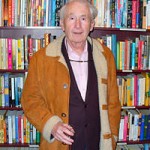 Sadly the great memoirist Frank McCourt has died from complications of metastatic melanoma.
Sadly the great memoirist Frank McCourt has died from complications of metastatic melanoma.
His first book Angela’s Ashes is one of my favorites. If you haven’t read it yet, pick up a copy and bring to life his words, especially if you have some poor Irish blood in you. One of the most memorable book openings I can think of begins:
When I look back on my childhood, I wonder how I survived at all. It was, of course, a miserable childhood: The happy childhood is hardly worth your while. Worse than the ordinary miserable childhood is the miserable Irish childhood, and worse yet is the miserable Irish Catholic childhood.
People everywhere brag and whimper about the woes of their early years, but nothing can compare with the Irish version: the poverty; the shiftless loquacious alcoholic father; the pious defeated mother moaning by the fire; pompous priests; bullying schoolmasters; the English and all the terrible things they did to us for 800 long years.
After a childhood full of adversity and poverty, McCourt immigrated to New York and eventually became a teacher. Among other things he taught his creative writing students that their own lives were their best material. Taking that advice to heart, he finally wrote his first book after retiring in his 60’s.
Melanoma, as you may know, is an ugly and tenacious adversary. It is estimated that 1 in 65 people in the US will be diagnosed with melanoma in their lifetime. You can learn more about the disease here at Medline, with particular attention paid to recognizing risk factors and maximizing prevention. News of McCourt’s diagnosis was released just 2 months ago, and he was undergoing chemotherapy as recently as May, 2009.
Speaking to students at Bay Shore High School on Long Island in 1997, he said, “I learned the significance of my own insignificant life.”
I think that sentiment is what I liked best about Angela’s Ashes. The insignificant tale of an unknown boy growing up in the slums of Limerick was not really unique – most people live uncelebrated lives of hardships overcome and adversities faced. But in the telling of his story Frank McCourt added a poignant thread to the grand human tapestry, and touched upon our common humanity.

 My wife and I have a pact that if we make it to our 90’s we are going to eat chocolate ice cream three times a day. Such reckless consumption of saturated fats would be quite tasty, even if it hastened our ultimate deaths. It’s a way of trivializing and coping with the stress of a more grave concern – that one day we might have so much pain, disability, incontinence, and dementia that admonitions like eating healthy seem petty and absurd. Plan B, for when the ice cream comes up in a bilious storm of vomit and nausea, is too upsetting to contemplate – yet people are forced to heroically consider it somewhere in the world, each day.
My wife and I have a pact that if we make it to our 90’s we are going to eat chocolate ice cream three times a day. Such reckless consumption of saturated fats would be quite tasty, even if it hastened our ultimate deaths. It’s a way of trivializing and coping with the stress of a more grave concern – that one day we might have so much pain, disability, incontinence, and dementia that admonitions like eating healthy seem petty and absurd. Plan B, for when the ice cream comes up in a bilious storm of vomit and nausea, is too upsetting to contemplate – yet people are forced to heroically consider it somewhere in the world, each day. I applaud President Obama’s choice for Surgeon General.
I applaud President Obama’s choice for Surgeon General.
 I almost never buy bottled water to drink. Instead I prefer to drink filtered water from the tap. But on a recent trip to New York City I have to confess that I coughed up a ridiculous $3 a bottle for “Fiji Natural Artesian Water.” I don’t know if it was the indulgence of being on vacation, or the less-deliciously presented bathroom sink of my hotel room, but I fell into the trap of paying for water three nights in a row. Fiji Water, according to their website, is “Far from pollution. Far from acid rain. Far from industrial waste. There’s no question about it: Fiji is far away. But when it comes to drinking water, ‘remote’ happens to be very, very good.”
I almost never buy bottled water to drink. Instead I prefer to drink filtered water from the tap. But on a recent trip to New York City I have to confess that I coughed up a ridiculous $3 a bottle for “Fiji Natural Artesian Water.” I don’t know if it was the indulgence of being on vacation, or the less-deliciously presented bathroom sink of my hotel room, but I fell into the trap of paying for water three nights in a row. Fiji Water, according to their website, is “Far from pollution. Far from acid rain. Far from industrial waste. There’s no question about it: Fiji is far away. But when it comes to drinking water, ‘remote’ happens to be very, very good.”